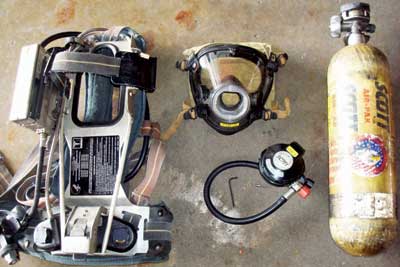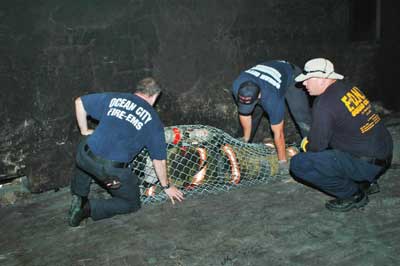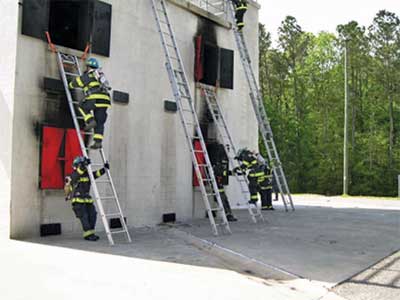BY TREVOR STEEDMAN
Firefighters are introduced to new technologies at an increasing rate, which helps us to perform fireground tasks with greater safety and efficiency. Unfortunately, many firefighters came to rely on technology such that they have allowed it to replace rather than enhance their basic firefighting skills. This occurred when firefighters first trained with thermal imaging cameras (TICs) and positive pressure ventilation (PPV) fans. Initially, with TICs, many firefighters abandoned their basic search skills and failed to remain physically oriented during searches, relying solely on the screen display to guide them through the structure to their objective. Then, when a TIC was dropped and couldn’t be recovered or the battery died, the firefighter might as well have been in the middle of the ocean without a compass trying to find land. These experiences forced us to revert to our basic search techniques to reorient ourselves and either continue our search or find our way out.
But what about those newer generations of firefighters who never had to routinely perform search without TICs and may not have developed these strong basic skills? Fortunately, this deficit has become largely recognized, and many of us now advocate that the firefighter carrying the TIC remain oriented to a door or a known point within the structure. To reinforce this point, many training officers throw the dead battery curveball to their firefighters when they reach the middle of the room being searched and don’t remain oriented to a door or window.
Likewise, when our departments purchased our first PPV fans, we watched the training video once before archiving it on a shelf at the firehouse. Maybe we even drilled with the fan at a controlled burn and then became instant “experts” on PPV. A few local departments in my area went a step further and hired an instructor to set up a PPV drill at a controlled burn in an acquired structure. A fire was ignited in a rear bedroom of the single-story structure and the PPV fan was fired up in the front door right on cue. All of the appropriate doors and structural openings had been strategically opened or closed to achieve the desired effect for the PPV magic show we were about to see. The instructor gave the firefighters a guided “walking tour” down the hallway toward the open door of the involved room. As the hoseline advanced down the hallway, he had the firefighters stand while they marveled at the illusions of cool, clear, and safe conditions leading up to the fire room.
Unfortunately, the fire didn’t follow the script. The rear window of the involved room had failed and self-vented. A coupling from the attack crew’s advancing hoseline knocked loose the aluminum patio chair used to chock open the front storm door. The storm door closed, blocking the PPV’s airflow, and the prevailing 20-knot wind pushed the fire back in the window and down the hallway toward the firefighters. In their standing position, the firefighters were immediately overwhelmed and chaos ensued. They failed to manage the hoseline as some attempted a running retreat while others reverted to the basics and dropped to the floor. Panicked screams and a rapid change in fire conditions drew the attention of the backup crew (prerapid intervention team), which made entry, knocked down the fire, and pulled their brother and sister firefighters to safety. Three firefighters and an instructor received second-degree burns and were transported to the hospital. They narrowly escaped with their lives.
Failing to consider and fully understand these tools’ capabilities and limitations resulted in poor operational practices, close calls, and near-misses that could easily have killed us. Similarly, many firefighters have lost their “survival skills” with their self-contained breathing apparatus (SCBA). Advanced technology is an adjunct, an asset, a tool—not a replacement for skills. Those who have been firefighters for a while have witnessed many SCBA changes and advancements. As they occurred, technologies were put in place to increase our safety and potentially reduce negative circumstances caused by human error.
For example, the initial mask-mounted heads-up display (HUD) provided an immediate visual indicator of remaining air at 75, 50, 25, and 10 percent of the cylinder capacity. At 25 percent or quarter service, the SCBA face piece provides an audible and tactile alert that is obvious to the wearer. In 2013, the National Fire Protection Association (NFPA) standard changes designated one-third as the end-of-service indicator.
In days gone by, we had to try to remember to manually check our strap-mounted air gauges and had no overt indication of low air until the bell rang on the bottom of the SCBA. This was usually followed by the shout, “Whose bell is that?” as we groped awkwardly behind our backs trying to feel the vibration to determine if our bell was the one in question. Although the HUD enhances our ability to consistently monitor our remaining air, it introduces additional psychological stressors that may challenge our ability to regulate air consumption. For example, when we see the two green indicator lights, we feel that we have plenty of air and all is well. As the air in our cylinder is consumed, the indicator lights gradually change from reassuring green to cautionary yellow and, ultimately, flashing red accompanied by an audible/tactile alert.
During SCBA drills, I have repeatedly observed firefighters’ air consumption rates (ACRs) increase when the visual indicators of remaining air change. This reaction often occurs when there are no additional stimuli, no appreciable changes in conditions, and no increased workload on the firefighter. As a corollary, when the visual, audible, and tactile stimuli increase, the ACRs incrementally increase. So, how do we benefit from this advanced technology without succumbing to its ancillary effects that increase the ACRs? Training!
SCBA training is nothing new. However, did your SCBA emergency procedures drills prepare you for almost any inevitability, or were you just “going through the motions”? Was good air management stressed and practiced? Did you spend more time learning about SCBA than on the drill ground using it? How often do you personally practice your SCBA and air management and survival skills? Have your drills and training kept up with the changes in technology? What have you done to master one of the most basic tools of your trade? Think about how often you wear SCBA on your back compared to the time it’s actually at work. How well do you know its components, capabilities, and limitations? Now is the time to find out.
SCBA drills can reemphasize good and bad habits. Creating SCBA drills is a challenge but also an opportunity to produce and instill solid SCBA practices and mask confidence for the firefighter. The more comfortable and familiar the firefighter is with his equipment, the better and more efficiently he will perform. Likewise, good air management practices become second nature when consistently performed during these drills. Here are some practices and drills that have proven effective in achieving that objective.
Air Management Techniques
Air management is a critical element of SCBA training. The overall objectives of the SCBA Bootcamp provide the firefighter with a comprehensive SCBA program, achieved through practical and realistic approaches, for surviving in an immediately dangerous to life or health (IDLH) atmosphere. Good air management techniques are introduced and practiced in the classroom and transition to the drill ground where they can be practically applied. Therefore, before the firefighter ever dons an SCBA face piece, that individual is taught how to breathe. Although discussed, the natural and involuntary process of breathing is not at issue. Rather, the focus is the firefighter’s understanding of the psychological and physiological effects of SCBA on this process. The emphasis is on cause, effect, and the firefighter’s ability to use SCBA survival techniques to overcome and mitigate air management challenges and emergencies. Simply stated, the firefighter must understand the “how” and “why” before he can perform the “what.”
There are many approaches and outlooks on air management techniques and practices. In the absence of empirical data, the “best practices” for air-conserving breathing techniques are often based more on opinions and conjecture; many disagreements persist. Conversely, other sources of information, some less formal, focus on practical and objective observations that may be taught, practiced, and applied to yield improved ACRs. Some of the controversy about using breathing techniques in the fire service results from adapting them from the areas outside our profession. Breathing techniques are used in athletics, vocal/speech training, and the playing of some musical instruments.
Any breathing methods that are adapted for firefighter air conservation purposes will have pros and cons. Most firefighters and instructors would concur that if a technique works and you can train on it; you can understand, use, and be comfortable with it; and it improves your survivability, stick with it.
Locally, we have trained, practiced, and instituted some standardized recommendations for air management breathing techniques. We have encouraged firefighters to practice these techniques during physical training/physical conditioning, drills, exercise, house duties, running, and so forth. Members who have taken these frequent opportunities to practice these techniques have consistently demonstrated greater mask confidence and improved ACRs in training and on the fireground. Ultimately, any good actions or techniques that can provide a few more precious seconds of air and save the life of a distressed firefighter are worth trying.
NFPA 1981, Standard on Open-Circuit Self-Contained Breathing Apparatus (SCBA) for Emergency Services (2013 Update), in part has again refocused our attention on air management. The end-of-service indicators have been modified to allow for additional emergency reserves of air. These changes obligate us to amend our SCBA air management policies and practices. Far too frequently, line-of-duty-death (LODD) reports include, “Contributing Factors: Air management doctrine not followed ….” Regrettably, many instructors (me included) have contributed greatly to this by our actions on the drill ground that follow us to the fireground. We have sent mixed messages about air management to our firefighters. Unfailingly, we will preach to the firefighters the importance of air management and situational awareness in allowing for adequate time to exit an IDLH atmosphere when the end-of-service indicators alert. However, we errantly follow up our sermon on the drill ground by failing to exit the burn building when our end-of-service indicators alert us.
Worse, firefighters have witnessed instructors reenter a burn building, alarms sounding, to squeeze in one more burn evolution so as not to “waste any time” during training to prematurely change or fill their SCBA cylinders. What you allow, you teach! NFPA 1404, Standard for Fire Service Respiratory Protection Training, provides us with a design by which to teach these vital SCBA skills including air management. This is particularly relevant considering the aforementioned 2013 NFPA standard’s update that directly impacts SCBA air management criteria.
Assembly Line
This very versatile drill accomplishes multiple objectives. SCBA familiarization instills confidence by conditioning the user to rapidly diagnose failures and address malfunctions. As such, this level of awareness makes transitioning to emergency breathing and escape procedures second nature. Like a Marine and his rifle, a firefighter must be intimately familiar with his SCBA’s working components. Certainly, we will not be “field stripping” an SCBA inside of an IDLH atmosphere. However, by breaking down the SCBA into its basic working components, the firefighter becomes intimately aware of the feel and location of each part, especially when he does it under obscured vision. A group of four to seven firefighters is ideal for this drill (photo 1).
 |
| Photos by author. |
First, disassemble the SCBA into as many parts as you have participants. Have the firefighters don obscured masks and individually place them in various parts of a room. The instructor then gives the objectives and instructions for the drill:
- Each participant will receive a part of the SCBA that they should be able to identify by touch.
- On the word “go,” the participants will work to find each other in the room and reassemble the SCBA.
- The participants have a goal of two minutes to complete the task. Time stops when the SCBA unit is fully re-assembled and air is flowing from the regulator (using the donning/doffing valve or the bypass).
This is a progressive drill that is initially performed with obscured masks only. Next, participants wear the SCBA and perform the drill while on air, then wearing fire gloves, and finally wearing full turnout gear. Ancillary benefits of the Assembly Line drill include encouraging and inspiring team building. Also, it is an excellent tool for assessing leadership potential in those firefighters who step up during the drill and initiate communication and coordination efforts.
D-Fence
A Mayday-based drill, D-Fence simulates a firefighter being trapped or pinned. Unlike other Mayday drills that allow the firefighter to remain mobile, this drill limits or denies the firefighter mobility by placing the member in a position that he cannot control or readily escape. The scenario is that of a firefighter conducting a search. As the firefighter is conducting the search, instructors drop a 6- × 8-foot section of chain-link fence over the unsuspecting firefighter (photo 2). The instructors stand or kneel on the corners of the fence, effectively rendering the firefighter immobile in whatever body position he was in at the time of the “collapse.” Note: Standing or kneeling on the corners of the fencing is more than sufficient to “trap” or “pin” the firefighter. Do not jump on the back or “dog pile” the firefighter! It is dangerous and unnecessary and can potentially cause the firefighter serious injury! This drill creates a “Mayday” situation and helps to evaluate the firefighter’s understanding and use of “Mayday” policies, procedures, and practices.

Ant Farm
The Ant Farm uses a basic fireground function to assist the firefighter in assessing and controlling ACRs under a consistent, working stress. A series of ladders of varying heights are thrown to a building and the firefighters must ascend and descend them in a particular order (photo 3). This drill is aptly named since the firefighters resemble ants steadily traversing the passageways of an ant farm. The firefighters gain experience with practicing a variety of breathing techniques during this drill. ACRs are recorded and correlated with the number of complete cycles the firefighter completes coupled with that person’s assessment of personal pace and exertion. This process establishes a matrix by which each firefighter gains a personalized perspective of his ACR capabilities and limitations. The Ant Farm also is an opportunity to reinforce proper climbing and heeling techniques.

Some safety considerations for this drill include the following:
- Tie off/secure ladders (highly recommended).
- Monitor participants for fatigue, cramping, overheating, and nausea.
- As with any such activity, hydrate, hydrate, hydrate.
- Do not exceed recommended ladder section loads.
- Position instructors at strategic locations to constantly monitor all participants and to provide immediate assistance if necessary. Prior to the drill, instructors should confirm assignments and contingencies should any mid-ladder or other participant issues arise.
- Maintain personnel accountability throughout the drill.
Displaying 1/2 Page 1, 2, Next>
View Article as Single page
Fire Engineering Archives

